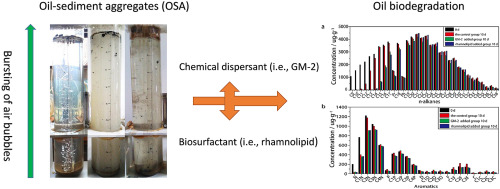当前位置:
X-MOL 学术
›
Int. Biodeterior. Biodegrad.
›
论文详情
Our official English website, www.x-mol.net, welcomes your
feedback! (Note: you will need to create a separate account there.)
Effects of suspended particulate matter, surface oil layer thickness and surfactants on the formation and transport of oil-sediment aggregates (OSA)
International Biodeterioration & Biodegradation ( IF 4.1 ) Pub Date : 2020-04-01 , DOI: 10.1016/j.ibiod.2020.104925 Haoshuai Li , Mutai Bao , Yang Li , Lanmei Zhao , Thomas King , Ying Xie
International Biodeterioration & Biodegradation ( IF 4.1 ) Pub Date : 2020-04-01 , DOI: 10.1016/j.ibiod.2020.104925 Haoshuai Li , Mutai Bao , Yang Li , Lanmei Zhao , Thomas King , Ying Xie

|
Abstract This study illustrated the significant effects of oil surface layer thickness, the presence of suspended particulate matter (i.e. sediment resuspension) and surfactants (chemical oil dispersants and a bio-surfactant) on the formation and transport of oil-sediment aggregates (OSA). Oil spill thickness on surface waters influenced the weathering rates of residual oil. Thin oil slicks on the water surface were more readily dispersed by physical processes. This study provided evidence for the dispersion of thin oil slicks by the bursting of air bubbles. The OSA formation within the water column by interaction of oil with suspended particulate materials promoted the sedimentation of oil. The addition of a chemical dispersant (i.e., GM-2) and biosurfactant (i.e., rhamnolipid) to a surface oil slick increased the dissolved and aggregated oil concentrations in the aqueous phase and subsequent oil biodegradation rates. These findings provide a deeper understanding on the processes influencing vertical distribution and environmental persistence of a crude oil spilled on the ocean surface both in the presence and absence of surfactant additions.
中文翻译:

悬浮颗粒物、地表油层厚度和表面活性剂对油沉积聚集体(OSA)形成和输送的影响
摘要 本研究阐明了油表层厚度、悬浮颗粒物(即沉积物再悬浮)和表面活性剂(化学油分散剂和生物表面活性剂)的存在对油-沉积物聚集体(OSA)的形成和运输的显着影响。地表水的溢油厚度影响残油的风化速率。水面上的薄油膜更容易通过物理过程分散。该研究为薄油膜通过气泡破裂而分散提供了证据。通过油与悬浮颗粒物质的相互作用在水柱内形成 OSA 促进了油的沉降。添加化学分散剂(即 GM-2)和生物表面活性剂(即,鼠李糖脂)到表面浮油增加了水相中溶解和聚集的油浓度以及随后的油生物降解速率。这些发现让我们更深入地了解了在添加和不添加表面活性剂的情况下,影响溢出到海洋表面的原油的垂直分布和环境持久性的过程。
更新日期:2020-04-01
中文翻译:

悬浮颗粒物、地表油层厚度和表面活性剂对油沉积聚集体(OSA)形成和输送的影响
摘要 本研究阐明了油表层厚度、悬浮颗粒物(即沉积物再悬浮)和表面活性剂(化学油分散剂和生物表面活性剂)的存在对油-沉积物聚集体(OSA)的形成和运输的显着影响。地表水的溢油厚度影响残油的风化速率。水面上的薄油膜更容易通过物理过程分散。该研究为薄油膜通过气泡破裂而分散提供了证据。通过油与悬浮颗粒物质的相互作用在水柱内形成 OSA 促进了油的沉降。添加化学分散剂(即 GM-2)和生物表面活性剂(即,鼠李糖脂)到表面浮油增加了水相中溶解和聚集的油浓度以及随后的油生物降解速率。这些发现让我们更深入地了解了在添加和不添加表面活性剂的情况下,影响溢出到海洋表面的原油的垂直分布和环境持久性的过程。











































 京公网安备 11010802027423号
京公网安备 11010802027423号